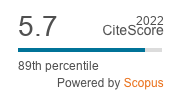Due to the increase of the human world population, modern-day research is looking for new methods of protein exploitation. Therefore the authors conducted a joint research project with the goal to automate the breeding of Tenebrio molitor as a novel protein source. An important task is to monitor the size of larvae in order to control the rearing process. In this work, a suitable algorithm is presented to measure the size distribution of the population. It is a combination of classical image processing functions and a neural net to enhance the dataset for a more reliable result. The output can be used to determine the most efficient time for harvesting. First, a grayscale picture of the insects in one box is taken and binarised by a threshold algorithm. The connected objects in this image are separated by an irregular watershed algorithm that delivers separate segments of larvae. Not all single segments can be used for measuring the size distribution; therefore, an artificial neural network is used for a classification. In the end, the algorithm separates the segments given by the watershed and categorises them into four categories: good segments, medium segments, bad segments, and artefacts. The good segments have a recall rate of 91.4%. In the end, the identified segments can be used to establish a method for determining the size distribution and, thus, to document the growth of the larvae.
RESEARCH ARTICLE
Noninvasive monitoring system for Tenebrio molitor larvae based on image processing with a watershed algorithm and a neural net approach
A. Baur Related information , D. Koch Related information
, D. Koch Related information
1Friedrich-Alexander-Universität Erlangen-Nürnberg, Institute of Fluid Mechanics, Cauerstr.4, 91058 Erlangen, Germany.
*Corresponding author: andreas.
*Corresponding author: andreas.
 , D. Koch Related information
, D. Koch Related information1Friedrich-Alexander-Universität Erlangen-Nürnberg, Institute of Fluid Mechanics, Cauerstr.4, 91058 Erlangen, Germany.
, B. Gatternig Related information2University of Applied Sciences Weihenstephan-Triesdorf, Department of Environmental Engineering, Markgrafenstraβe 12, 91746 Weidenbach, Germany.
, A. Delgado Related information1Friedrich-Alexander-Universität Erlangen-Nürnberg, Institute of Fluid Mechanics, Cauerstr.4, 91058 Erlangen, Germany.
Journal of Insects as Food and Feed: 8
(8)- Pages: 913 - 920
Published Online: March 18, 2022
Abstract
Keywords: insect rearing, automation, machine learning
2022 Journal Impact Factor
5.7
source: Journal Impact Factor 2023™ from Clarivate™

Institutional Offers
For institutional orders, please contact [email protected].
Purchase Options
-
G. Daş, M.M. Seyedalmoosavi, K. Schleifer, M. Mielenz and C.C. Metges
-
-
M. Barrett, S.Y. Chia, B. Fischer and J.K. Tomberlin
-
D.G.A.B. Oonincx and M.D. Finke
-
M. Reverberi
-
K.B. Barragan-Fonseca, M. Dicke and J.J.A. van Loon
-
A. van Huis
-
M. Tschirner and A. Simon
-
S. Kelemu, S. Niassy, B. Torto, K. Fiaboe, H. Affognon, H. Tonnang, N.K. Maniania and S. Ekesi
-
M.B. Ruby, P. Rozin and C. Chan
Editor's Choice: Birgit Rumpold



